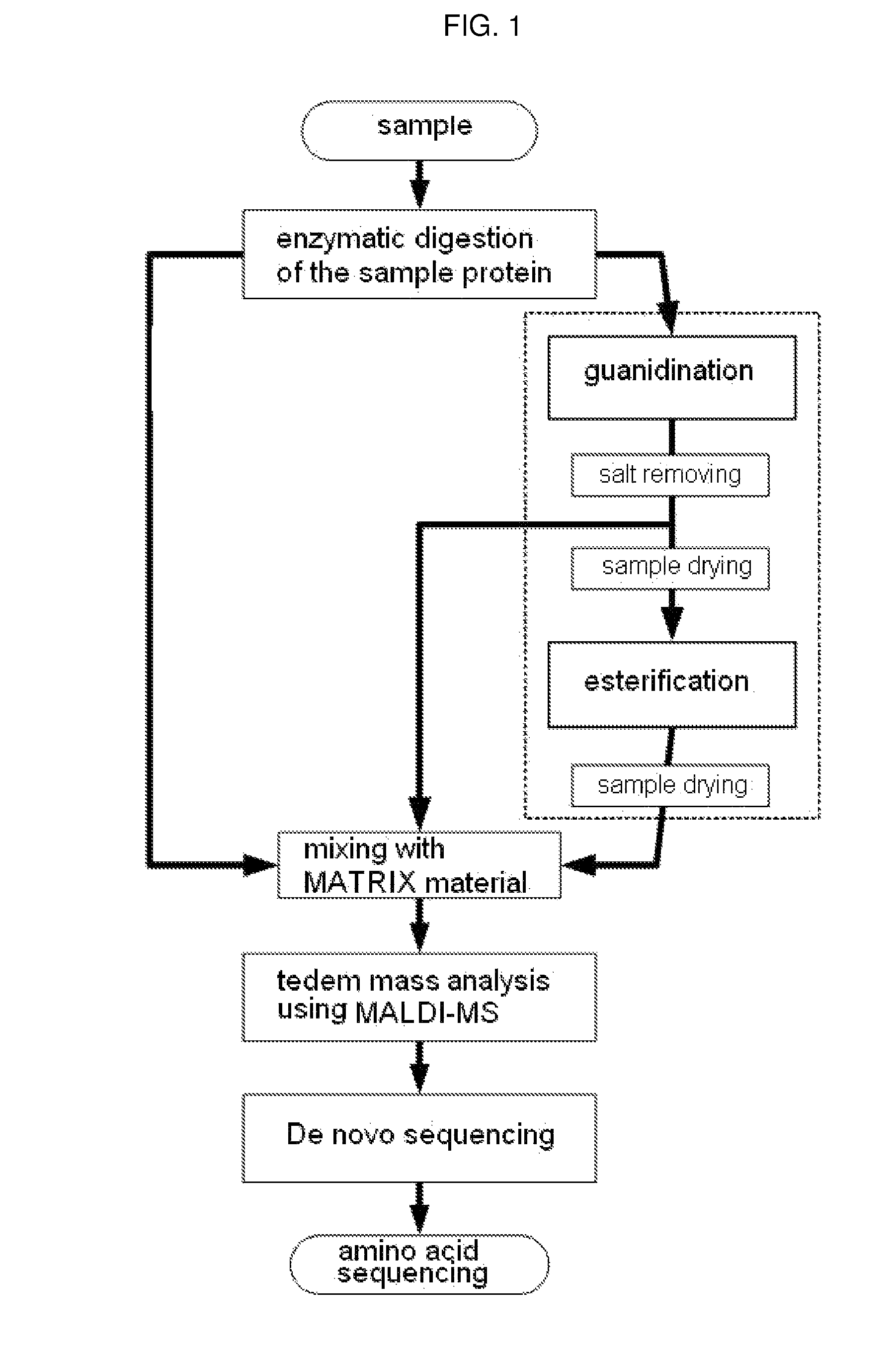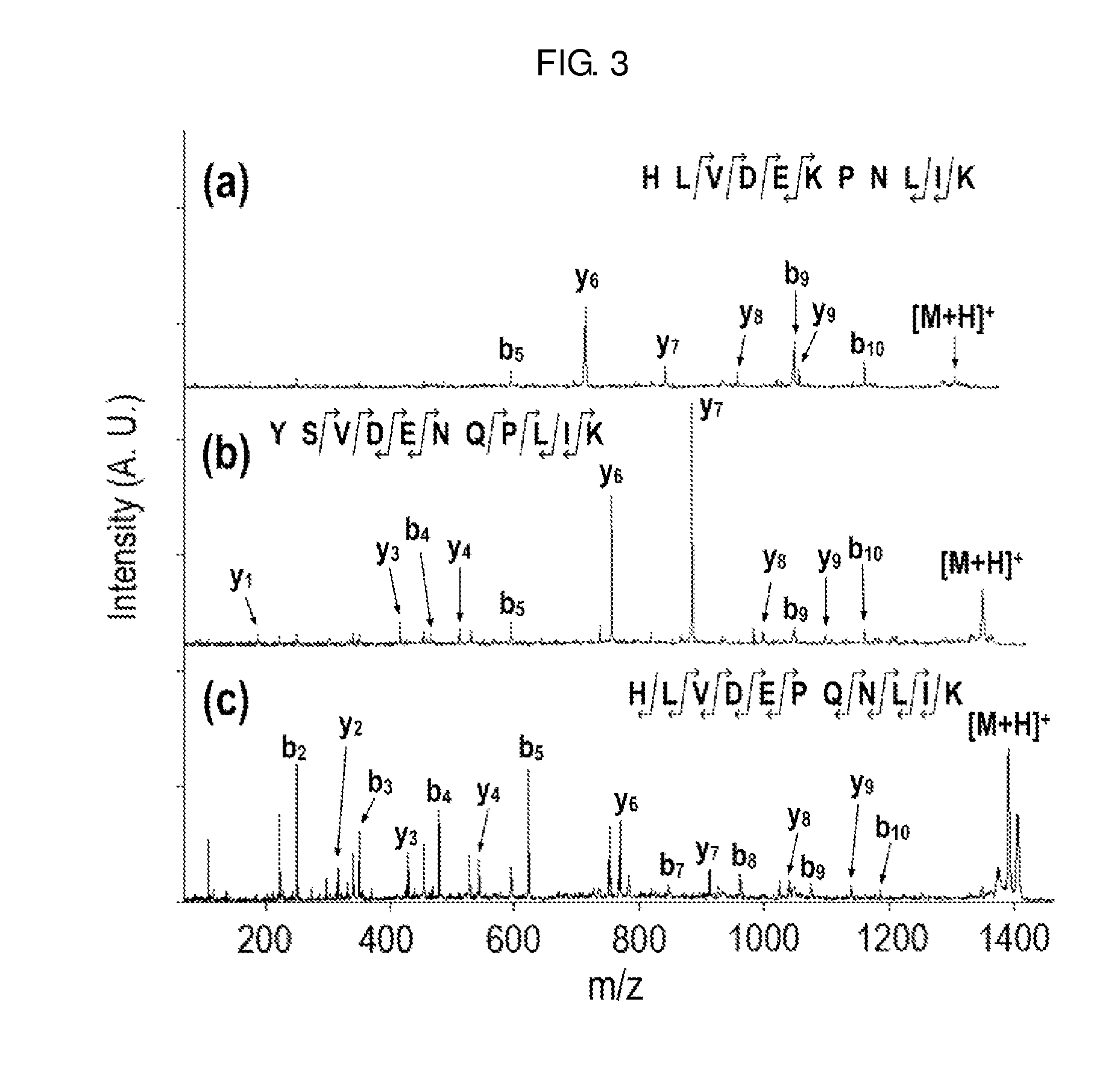Method of de novo sequencing of peptide using the MALDI mass spectrometry, method and apparatus for preparing sample for MALDI mass spectrometry
a peptide and mass spectrometry technology, applied in the field of de novo sequencing of peptides using the maldi mass spectrometry, can solve the problems of limited number of proteins that can be analyzed, limited detection sensitivity of current techniques, and long sequencing time, so as to improve the detection sensitivity of peptides, reduce sample detection limits, and wide variation of detection sensitivity
- Summary
- Abstract
- Description
- Claims
- Application Information
AI Technical Summary
Benefits of technology
Problems solved by technology
Method used
Image
Examples
example 1
[0073]In order to confirm the effect of the two-step chemical modification on de novo sequencing, the two-step chemical modification was applied to the well-established bovine serum albumin (BSA) sequencing.
[0074]1-1: Treatment and Analysis of BSA
[0075]BSA was cleavaged to peptides by porcine trypsin. Two-step chemical modification of guanidination and methyl-d0 (or methyl-d3) esterification was performed on the resulting tryptic peptides. The modified samples were analyzed using a 4700 Proteomics Analyzer, a MALDI tandem mass spectrometer, and then de novo sequenced using PEAKS Studio.
[0076]The guanidination was carried out by adding 5.5 μL of aqueous ammonia (7N) and 1.5 μL of an aqueous guanidination solution (O-methylisourea, 10 mg / 10 μL) to 5 μL of the tryptic peptide solution and performing the reaction for 10 minutes in an oven at 65° C. 10% (v / v) trifluoroacetic acid was added to terminate the reaction and the solvent was removed by lyophilization. 8 μL of distilled water wa...
example 2
[0100]Two-step chemical modification of guanidination and methyl-d3 esterification was applied to sequencing of the proteins extracted from yeast in order to confirm the applicability of the two-step chemical modification in actual de novo sequencing.
[0101]2-1: Extraction of Proteins from Yeast
[0102]Proteins were extracted from yeast whole cell extract-prt part by chromatin immunopreciptation as follows.
[0103]1) Prepare 100 mL of cultures (OD600≈1.2-1.5)
[0104]2) Crosslink[0105]Add 2.7 mL of 37% HCHO (final conc.: ˜1%)[0106]Shake gently for 2 hrs at R.T.
[0107]3) Harvest and resuspend cells with 800 ul of lysis buffer.
[0108]4) Freeze with liquid nitrogen and thaw at R.T. (×4)
[0109]5) Shear chromatin[0110]Sonicate extracts for 10× 10 sec pulses.[0111]In between 10 sec pulses, let samples sit on ice for 1-2 min.
[0112]6) Clarify samples[0113]Centrifuge at max speed for 10 min and 15 min at 4° C.
[0114]7) Measure the volume
[0115]8) Immunoprecipitae (IP) rest of lysate and 50 ul of Anti-HA ...
example 3
[0157]FIG. 11 shows the liquid sample electrosprayed at the ESI tip. Inner diameter of the ESI tip ranged from 500 nm to 30 mm. Flow rate of the liquid sample was controlled within from 200 mL to 2 mL per minute.
PUM
| Property | Measurement | Unit |
|---|---|---|
| mass | aaaaa | aaaaa |
| diameter | aaaaa | aaaaa |
| crystal diameter | aaaaa | aaaaa |
Abstract
Description
Claims
Application Information
 Login to View More
Login to View More - R&D
- Intellectual Property
- Life Sciences
- Materials
- Tech Scout
- Unparalleled Data Quality
- Higher Quality Content
- 60% Fewer Hallucinations
Browse by: Latest US Patents, China's latest patents, Technical Efficacy Thesaurus, Application Domain, Technology Topic, Popular Technical Reports.
© 2025 PatSnap. All rights reserved.Legal|Privacy policy|Modern Slavery Act Transparency Statement|Sitemap|About US| Contact US: help@patsnap.com



